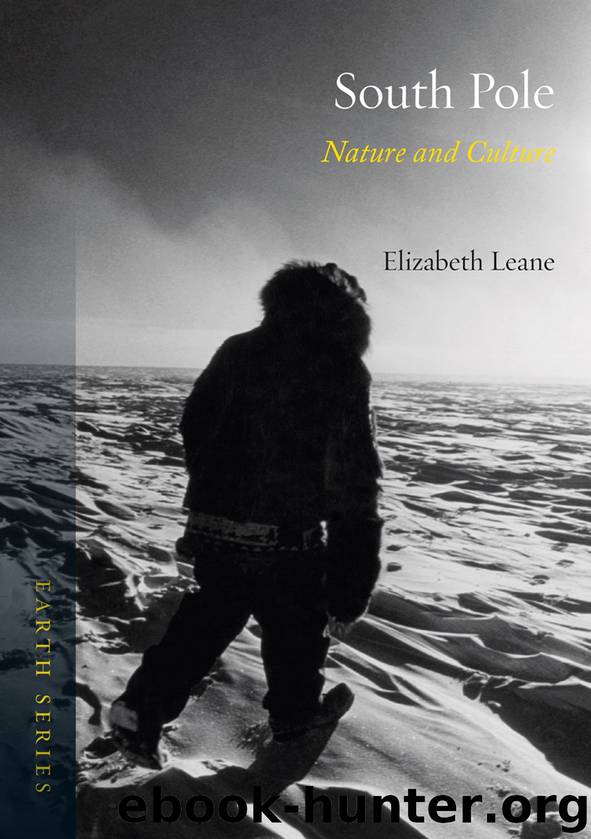South Pole by Elizabeth Leane

Author:Elizabeth Leane
Language: eng
Format: epub
Publisher: Reaktion Books
7 Looking Up and Looking Down
The South Pole’s unusual combination of physical features gives it peculiar advantages as a site for scientific investigation. However, the science that takes place at the South Pole is not necessarily about the place itself. There is no wildlife to observe there, no trees or flowers to study, no exposed rock to examine. Instead, the Pole is an excellent place to look from, whether this is up into space or down into the ice – or into the core of the Earth. Research that seems very local can have global – even cosmic – significance.
Not just the Pole but the whole polar plateau offers itself as a site for research. The plateau’s physical extremes – its status as the highest, driest, coldest, most isolated and, for some months of the year, darkest region on Earth – bring unique scientific advantages. There are, admittedly, specific benefits for some experiments in being on the Earth’s rotation axis (the Pole itself). For much scientific work, however, there are many places on the plateau, including other stations, that are as good as or better than 90 degrees south, judged purely on environmental conditions. The Pole’s advantage – ironically, for the ‘last’ place on Earth – is its comparative accessibility and pre-existing infrastructure. Heavy equipment can be flown in and out by U.S. military aircraft or hauled across the ice on motorized vehicles along a pre-smoothed ‘road’. Scientific and support personnel in the hundreds can be accommodated in the station and nearby ‘summer camp’.
A wide variety of scientific experiments take place at the South Pole. Its clean air, which is free from most of the usual local pollutants, is used to determine wide-scale changes to atmospheric composition; levels of carbon dioxide and ozone have been continually monitored for around 50 years. In its long winter darkness, auroras are studied for what they can tell us about space weather (the environmental conditions of the region of space near Earth). NASA uses the interior of Antarctica as an analogue for the terrain and temperatures of Earth’s neighbouring planet Mars. Even scientists themselves become subjects of study by psychologists interested in the dynamics of isolated groups. However, the South Polar science that attracts most attention – and costs the most money – involves examining data found in the sky above or the ice below.
Antarctica provides the world’s best conditions for astronomical research. While some forms of astrophysics can be conducted from coastal bases such as McMurdo and Mawson stations, it is the plateau that offers astronomers ‘the best seeing conditions, the darkest skies and the most transparent atmosphere’.1 The plateau’s primary attraction for astronomers (who use numerous techniques, including optical, radio and infrared telescopes) is its high, cold, dry and isolated location. For telescopes looking at the microwave and infrared radiation arriving from deep space, the dry air is paramount. Water vapour absorbs and re-emits the radiation, interfering with the data. Both the height of the plateau and the cold temperature reduce water vapour significantly.
Download
This site does not store any files on its server. We only index and link to content provided by other sites. Please contact the content providers to delete copyright contents if any and email us, we'll remove relevant links or contents immediately.
Welcome to the Goddamn Ice Cube by Blair Braverman(1601)
Iced In by Chris Turney(1579)
Arctic Dreams by Barry Lopez(1416)
The White Darkness by David Grann(1321)
Mawson's Will by Lennard Bickel(1146)
Big Dead Place: Inside the Strange and Menacing World of Antarctica (Large Print 16pt) by Nicholas Johnson(1116)
Caroline Alexander by The Endurance: Shackleton's Legendary Antarctic Expedition(1099)
The Stowaway by Laurie Gwen Shapiro(1031)
Mummies and Pyramids by Mary Pope Osborne(980)
South Pole by Elizabeth Leane(979)
Tip of the Iceberg by Mark Adams(976)
Bound by Ice by Sandra Neil Wallace(965)
In the Kingdom of Ice by Hampton Sides(964)
Ice! by Tristan Jones(963)
Home by Beth Powning(925)
The Ice Balloon: S. A. Andree and the Heroic Age of Arctic Exploration by Wilkinson Alec(900)
Ice Diaries by Jean McNeil(864)
The Snow Walker by Farley Mowat(837)
Future Arctic by Edward Struzik(817)
